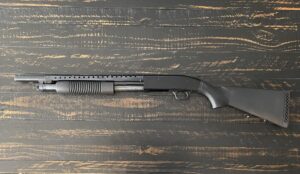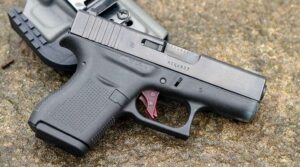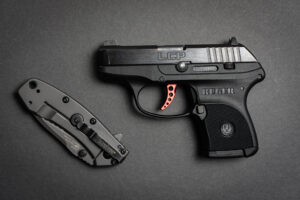Shotguns
A Guide to Understanding the Power of Scatterguns
Showing all 4 results
Showing all 4 results
Shotguns: A Guide to Understanding the Power of Scatterguns
We all know that the Terminator didn’t need any guns to be the coolest guy around, but they certainly helped define his image, alongside his black sunglasses and motorcycles. Among all the firearms seen in movies, shotguns stand out as one of the most iconic, memorable weapons. From their intimidating appearance to their powerful performance, shotguns captivate our attention on and off the screen.
While we don’t suggest you walk around the city like the Terminator with a shotgun slung over your shoulder, shotguns have many legitimate uses. And the best part? You don’t just have to watch them in the movies—you can own one right here.
But what exactly sets shotguns apart from other firearms? Is it just any gun that shoots? Let’s dive into what makes a shotgun truly unique.
What is a Shotgun?
A shotgun is a long-barreled firearm that fires straight-walled cartridges, commonly known as shells. Unlike other firearms, which may fire single bullets, shotguns are capable of discharging smaller sub-projectiles called shots. In some cases, shotguns can also fire a single, solid projectile known as a slug. The versatility of a shotgun’s ammunition makes it a popular choice for various applications, including hunting, sport shooting, and home defense.
Most shotguns are smoothbore, meaning their barrels lack the rifling found in other firearms, but rifled shotguns are used when shooting slugs for greater accuracy.
Types of Shotgun Actions
Just like there are different types of ammunition, shotguns themselves come in several different varieties based on the action type. Many people only think of pump-action shotguns, but there are several other kinds that each serve a different purpose.
Pump-Action Shotguns
When most people picture a shotgun, the pump-action is likely what comes to mind. These shotguns require the shooter to pump the forend to eject the spent shell and chamber a new one. Pump-action shotguns are reliable and versatile, making them a great option for hunting and home defense.
Semi-Automatic Shotguns
Semi-automatic shotguns are designed to fire one round with each pull of the trigger, automatically ejecting the spent shell and chambering the next. This allows for quicker follow-up shots without needing to manually pump the shotgun. Semi-autos are a favorite for sport shooting and hunting.
Over-Under and Side-by-Side Shotguns
Both over-under and side-by-side shotguns are double-barreled shotguns, but they differ in how the barrels are arranged. In over-under shotguns, the barrels are stacked vertically, while in side-by-side shotguns, the barrels sit next to each other horizontally. These shotguns are popular for clay shooting and hunting.
Shotgun Gauge
One of the key ways to categorize shotguns is by their gauge. The gauge of a shotgun refers to the inner diameter of the barrel and is measured by the weight of a solid lead ball that would fit inside the bore.
- 12 gauge is the most common shotgun gauge and is suitable for a wide variety of uses, from home defense to hunting.
- 20 gauge shotguns are lighter and produce less recoil, making them great for beginners or those hunting smaller game.
- .410 bore is unique in that its measurement is given in inches, not by gauge. It’s typically used for small game or as a training shotgun due to its light recoil.
At Gritr Sports, we offer a diverse collection of shotguns from top brands such as CZ, Savage, and Mossberg. Whether you’re looking for a 12 gauge for home defense or a lightweight .410 for sport shooting, we have you covered.
FAQs About Shotguns
1. What are the main types of shotguns?
The main types are pump-action, semi-automatic, over-under, and side-by-side shotguns. Each type has its own unique benefits and uses.
2. Can I purchase a shotgun if I’m under 18?
No, you must be at least 18 years old to purchase a shotgun. Some states or regions may have additional age restrictions, so it’s essential to check local laws.
3. How do I choose the best shotgun for hunting?
The best shotgun depends on the type of game you are hunting. For smaller game, a .410 bore or 20 gauge shotgun may be ideal. For larger game, consider a 12 gauge shotgun.
4. What kind of ammunition does a shotgun use?
Shotguns typically use shells, which can contain birdshot, buckshot, or a single projectile called a slug.
5. Is it possible to mount accessories on shotguns?
Yes, many shotguns have built-in rails or attachment points where you can mount accessories like scopes, lights, or additional grips.
6. What’s the difference between birdshot, buckshot, and slugs?
- Birdshot consists of small pellets and is commonly used for hunting birds and small game.
- Buckshot consists of larger pellets and is typically used for hunting larger game or home defense.
- Slugs are single, solid projectiles used for hunting large game or situations requiring greater accuracy.
7. What’s the most popular shotgun gauge?
The 12 gauge is the most popular due to its versatility and availability for various applications like hunting, sport shooting, and home defense.
8. Do I need a license to own a shotgun?
This depends on your location. Some regions require licenses or permits to own a shotgun, so it’s essential to consult local firearm laws.
9. What’s the effective range of a shotgun?
The effective range varies by ammunition type. Birdshot is effective up to 40 yards, buckshot up to 50 yards, and slugs can reach up to 100 yards or more.
10. How do I clean a shotgun?
To clean a shotgun, you should disassemble it according to the manufacturer’s instructions, clean the barrel, remove residue from the action, and lightly oil the moving parts.
11. What is a rifled shotgun barrel used for?
A rifled barrel is typically used for firing slugs, as it imparts a spin to the projectile, improving accuracy over longer distances.
12. What’s the best shotgun for beginners?
A 20 gauge pump-action shotgun is often recommended for beginners due to its manageable recoil and versatility.
13. Can a shotgun be used for home defense?
Yes, shotguns, especially 12 gauge models loaded with buckshot, are commonly used for home defense due to their stopping power and spread.
14. What’s the difference between a smoothbore and rifled barrel?
A smoothbore barrel lacks rifling and is used primarily for shooting shotshells, while a rifled barrel has spiral grooves for improved accuracy with slugs.
15. What is an over-under shotgun used for?
An over-under shotgun is often used for clay shooting and hunting birds due to its precision and the ability to fire two shots quickly.
16. How much recoil does a 12 gauge shotgun have?
A 12 gauge shotgun produces moderate to heavy recoil, depending on the ammunition. Beginners may find the recoil more manageable with 20 gauge shotguns.
17. Can I use a shotgun for deer hunting?
Yes, slugs are often used in shotguns for deer hunting, especially in areas where rifle hunting is restricted.
18. What’s the difference between pump-action and semi-automatic shotguns?
A pump-action shotgun requires manual action between shots, while a semi-automatic shotgun automatically chambers the next round.
19. Can I use a shotgun for waterfowl hunting?
Yes, 12 gauge and 20 gauge shotguns loaded with birdshot are commonly used for waterfowl hunting.
20. What brands of shotguns does Gritr Sports carry?
We carry top brands like CZ, Savage, Mossberg, and many more. Our selection ensures you’ll find the perfect shotgun for your needs.







